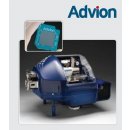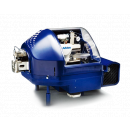应用领域:
资料类型:PDF
Drug Metab Dispos. 2012 Mar;40(3):419-25. doi: 10.1124/dmd.111.043562. Epub 2011 Dec 19. Investigation of figopitant and its metabolites in rat tissue by combining whole-body autoradiography with liquid extraction surface analysis mass spectrometry. Schadt S1, Kallbach S, Almeida R, Sandel J. Abstract
This article describes the combination of whole-body autoradiography with liquid extraction surface analysis (LESA) and mass spectrometry (MS) to study the distribution of the tachykinin neurokinin-1 antagonist figopitant and its metabolites in tissue sections of rats after intravenous administration of 5.0 mg/kg figopitant. An overview of autoradiography results is presented together with mass spectrometry identification and semiquantification of parent drug and its metabolites based on LESA-MS. The quality and accuracy of data generated by LESA-MS were assessed in comparison with classic tissue extraction, sample cleanup, and high-performance liquid chromatography analysis. The parent drug and the N-dealkylated metabolite M474(1) (BIIF 1148) in varying ratios were the predominant compounds in all tissues investigated. In addition, several metabolites formed by oxygenation, dealkylation, and a combination of oxygenation and dealkylation were identified. In summary, the LESA-MS technique was shown to be a powerful tool for identification and semiquantification of figopitant and its metabolites in different tissues and was complementary to quantitative whole-body autoradiography for studying the distribution.
Sample Analysis by LESA-MS. Samples obtained from the freeze-dried, 30- m whole-body sections were analyzed using a linear ion trap LTQ/Orbitrap hybrid mass spectrometer (Thermo Scientific) (Hu et al., 2005) equipped with a TriVersa NanoMate nanospray ion source (Schultz et al.,2000; Ramanathan et al., 2007).









